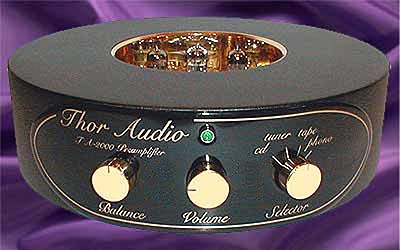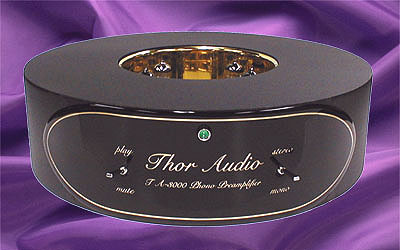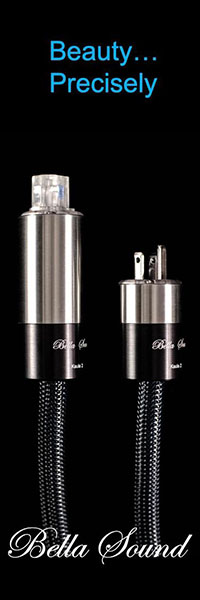Thor Audio TA-1000 Line Stage and TA-3000 Phono Stage
| Thor Audio TA-1000 Line Stage and TA-3000 Phono Stage |
|
Preview To Mark II |
|
Michael Wright |
|
January 2005 |

Upon hearing from a friend of mine that I was writing reviews for ST and using the Mark I version of his TA-1000 and TA-3000 line and phono stages, Thor Audio’s Paul Marks contacted me and offered to update my units to the current Mark II specifications. A full of review of the Mark II units is in the works so be on the look out for it in the coming months. It should be very exciting. In the meantime, I want to share with you the effects of the Mark II update that was performed on my units as a prelude to the coming Mark II review. For those of you who are owners of the Mark I units, the update is no longer available. Sorry. But I think after you read this, you’ll be as excited about the Mark II as I am.
Thor Audio has been around since 1996 and from the time they made their move on the audio scene, their equipment has been considered as some of the best available. I had heard about their TA-1000 line stage before it was ever reviewed. I heard that it was to be a vacuum tube based unit with phenomenal sound and a shape that was a total departure from usual black box. It was shaped like a doughnut. When I first heard the Thor at the local salon (Holm Audio in Woodridge, IL), the hype was immediately justified. Here was a vacuum tube preamp that didn’t sound like tubes in the traditional sense. It was powerful and highly detailed sounding.

I then had an opportunity to hear Thor’s TA-3000 phono preamp and became hooked. Still owning an analog rig and enjoying the sound of vinyl, the TA-3000 bought me closer than anything I had previously heard, save the Klyne System Seven phono preamp, to audio Nirvana. The Thor phono preamp was the first piece of Thor electronics I came to own and still consider it my most prized piece for what it does for my vinyl listening. What it does is allow vibrant living music to bloom with so much naturalness that it captivates my senses. This phenomenon was consistent with every line stage that I connected it to. The TA-1000 took a little more effort to decide upon. I listened to quite a few preamps before I decided upon it. Other designer’s preamps that made the final cut were the Hovland, Audio Research LS25MKII, Joule-Electra LA-100 and the Lamm L1. The reason I went with the Thor line stage was because it combined the naturalness of tubes in the midrange with the extended frequency extremes of the best solid-state pieces and explosive dynamics like I had not heard before. When Thor came out with the “Mark II” upgrade, I was a little skeptical at first. I felt that my line and phono stages were sounding good enough as it were, and that upgrading would probably not give me much in return for what the cost of the upgrades would be.
There is one thing I need to make clear before going any further. What I am reporting on to you is a Thor TA-1000 and TA-3000 that were Mark I and have been upgraded to Mark II. The performance of the pieces will be, according to Paul Marks, owner and designer of Thor Audio, about 90% of what a brand new Mark II version of the same pieces. The new Thor Mark II linestage and phono preamp have a more substantial chassis, which adds to the improved sound. According to information taken directly from Thor’s site, “The circuit changes are many and give frequency extension into the deep bass for a deeper, tighter sound. It can also deliver this bass into any impedance, even into low impedance solid-state power amps. Other improvements include greater air, transparency, and focus of the image, and even more effortless overall presentation. More changes include better dynamics, inner (micro and macro) detail, and an even more palpable overall presentation.” One of the features that is available with the Mark II version are the availability of a remote. I used to take pride in claiming myself to be an audio purist who wouldn’t dream of using a remote control with my preamp. I will admit that remotes are becoming less of a convenience and more of a necessity thanks in part to some old football injuries (peewee football, but football nonetheless).
So how does it sound?
Before the upgrade, I was very happy with my two Thor pieces. I didn’t feel as though I was lacking in any one area of the music and my enjoyment of my system was quite high. But after finding out through a mutual acquaintance that I was still using the earlier Thor pieces, Paul made me an offer I couldn’t refuse.
I upgraded the TA-1000 first.
As I mentioned before, I’d bought a lot of preamps home before deciding on the Thor and had not heard anything up to that point that caused me to regret my decision. Well, my jaw dropped when I finally plugged in the updated TA-1000 and began to listen to the music. The first thing I noticed was that music seemed to be coming from a darker, quieter background, which made everything seem clearer and more distinct. Through the original TA-1000, I always felt that the performers sounded as though they were right in my room. But with the Mark II they were definitely more vivid and present. On live recordings, room sounds were much more apparent. I could easily tell when performers walked across the stage or were tapping their feet to set the tempo at the beginning of a track such as “Black Magic Woman”, on Patricia Barber’s, Companion and the Ray Brown Trio’s, Live at the Loa.
Bass performance was greatly improved as well. I had always felt that the original Thor had some of the best bass performance of any of tube preamp I’d heard. Through the Mark II, the bass went even deeper and with a bit more fullness. Steve Roach and Robert Rich’s “SOMA”, from The Absolute Sound’s Hearts of Space and “Chin Lang”, from the Lonnie Plaxico recording Plaxico were good examples of recordings whose bass was rendered better through the Mark II. The upgrade did little to the already outstanding dynamic performance and transient response.
I remarked during my Sonic Euphoria passive linestage review that the Thor, for an active device, was almost as neutral. With the upgrade, the Thor took on an improved sense of neutrality, and the Sonic Euphopria no longer sounded better in the area of string reproduction. Voice reproduction also improved with the upgrade. I could hear more of the vocal inflections, breathing and tone than I could before while listening to “Never Let Me Go” and “Detour Ahead” from Jane Monheit’s, Never Never Land and “A Case of You”, from Diana Krall’s CD Live in Paris. Not that I had any difficulty discerning those attributes before, but they were more apparent now. Stage width and depth are improved with each performer having more dimensionality and space between them as heard on “C Jam Blues”, from the Charles Mingus album, Mingus at Carnegie Halland “Castilian Drums” from Dave Brubeck’s, The Dave Brubeck Quartet at Carnegie Hall.
The result of the upgrade to the Thor TA-3000 phono preamp, while not quite as dramatic as was the linestage, was still very apparent. Again, music appeared to come forth from a quieter background that made the music from vinyl sound even more “you are there.” The high frequency performance was improved with greater extension and air on “Kaimana” from Steve Kindler & Teja Bell’s album, Dolphin Smiles. Midrange performance remained good with a slight increase in presence on “Look What I Got”, from Betty Carter’s wonderful Look What I Got, and Lush Life, from John Coltrane & Johnny Hartman . I found it easier to follow individual instrumentalists during complicated or dissonant passages as in avant-garde jazz as on “Beauty is a Rare Thing”, from The Ornette Coleman Quartet album, This is Our Music, and the Art Ensemble of Chicago’s Bush Magic, from their Urban Bushmen album . Upper bass and midbass were slightly fuller and had more impact as on, “The Nearness of You”, from Branford Marsalis’ album Trio Jeepy, Joe Henderson’s, “Loose Change”, from the album, The State of the Tenor, Live at the Village Vanguard. Classical music took on a more layered affect, front to back, with plenty of air and ambience. Strings sounds were very detailed, whether bowed or plucked, and horn sections sounded as though 16 distinct horns were coming together instead of 6 as on Lawrence Leighton Smith and Dmitri Kitayenko and The Moscow Philharmonic Orchestra’s performance of, The Moscow Sessions, and Howard Dunn and the Dallas Wind Symphony’s Fiesta.
Conclusion
A Thor TA-3000 phono preamp sounds wonderful in any version you really owe it to yourself and your vinyl collection to experience one at home. The TA-1000 linestage is a little more interesting and requires some deeper thought. You will have to come to that conclusion on your own. Based on what I heard in a dealers listening room, I didn’t think the upgrades would be worth it. My initial thought was that it was a little bit better, but my system already sounds good. However, after having heard the upgraded Thor units in my system, I had to conclude that they were worth the money for the improvements I got. If it brings you closer to the music and increases your musical enjoyment then,,,,,,,,check with the significant other and see if it’s okay and do it. Or you could buy brand new Mark II units that have the new and improved chassis that, according to Paul Marks, perform even better than updated units. Either way, you can’t lose and will have one of the best available.
![]()
Don’t forget to bookmark us! (CTRL-SHFT-D)
Stereo Times Masthead
Publisher/Founder
Clement Perry
Editor
Dave Thomas
Senior Editors
Frank Alles, Mike Girardi, Russell Lichter, Terry London, Moreno Mitchell, Paul Szabady, Bill Wells, Mike Wright, and Stephen Yan,
Current Contributors
David Abramson, Tim Barrall, Dave Allison, Ron Cook, Lewis Dardick, John Hoffman, Dan Secula, Don Shaulis, Greg Simmons, Eric Teh, Greg Voth, Richard Willie, Ed Van Winkle, Rob Dockery, Richard Doran, and Daveed Turek
Site Management Clement Perry
Ad Designer: Martin Perry





Be the first to comment on: Thor Audio TA-1000 Line Stage and TA-3000 Phono Stage